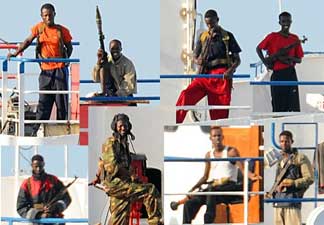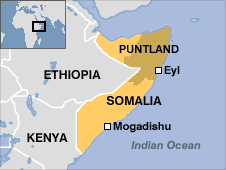|
Who are Somali pirates?
Main
Article page |
Beauty articles
|
Health page |
Computers|
Diseases |
Education |
Entertainment |
Family
Business |Fitness|
Fruits and Vegetables
|
Jobs |
General |
Personality|
Technology
|
Tourism |
Useful Tips
Biography Page|
Heroes & Incredible peoples
|
Inventions

Somali pirates have been making headline
almost every day that they have hijacked a new ship. According to a recent
report, In 2010 , Somali pirates have hijacked more than 49 ships and seized a
record 1,181 hostages. They were paid about 238 millions of dollars in
ransom. Piracy has been a big problem in Somali waters for at least 10 years.
Let us find out who are these modern-day pirates where and how they operate,
and why they've turned from fishing to piracy.
Where
do Somali Pirates Operate?
Somalia has a
huge coastline wrapped around the Horn of Africa. The Gulf of Aden, located
between Somalia and Yemen, was the focal point of pirate activities. This route is one of the busiest shipping lanes, where about
30,000 merchant vessels pass through annually on the way in and out of the Suez
Canal.
pirate activities. This route is one of the busiest shipping lanes, where about
30,000 merchant vessels pass through annually on the way in and out of the Suez
Canal.
Despite
the security threat, many ships continue to ply that route as the Suez is the
quickest way from Asia to Europe and America. Taking advantage of a country
without a stable government, the pirates attacked several vessels .
At any
given time pirates are holding at least a dozen ships hostage including the
occasional oil supertanker for which they can demand up to $25 million in
ransom. Most of the hijacked vessels are kept by the well-armed pirate gangs at
port Eyl
Pirates
are using "mother ships" so they can launch attacks further out at sea. A speed
boat consists of 5 to 10 pirates were sent to hijack the ship from these mother
ships. Somali pirates don't wear eye patches ( like the pirates in the movie"
Pirates of the Caribbean" ), and instead of swords they have RPGs
(rocket-propelled grenades). This RPG’s and small arms are used to intimidate
the operator to slow down and allow boarding. Light ladders are brought along to
climb aboard. Pirates then will try to take control of the vessel. They often
attack at night.
Who are
These Pirates?
Few years
ago, Somalis were lived with the fishing and foreign aid. Since there was no
proper Govt., and Civil war was going on, foreign vessels started illegal
fishing and dumping toxic wastes to Somali waters. This seriously affected their
livelihood. . European companies found it to be very cheap to get rid of the
waste, costing as little as $2.50 a tonne, where waste disposal costs in Europe
are something like $1000 a tonne. Also due to dumping of toxic waste, several
cases of respiratory infections, mouth ulcers, abdominal hemorrhages and
unusual skin infections started affecting the people. Since there was no shore
protection, Somali fishermen armed themselves to protect the waters and started
demanding a compensation tax . Slowly they started hijacking other ships to
make easy money . They claim that they are not pirates but coast guards.
The pirates consists of 3 types of people.
•Ex-fishermen, who are considered the brains of the operation because they know
the sea
•Ex-militiamen, who are considered the muscle - having fought for various Somali
clan warlords
•The
technical experts, who are the computer geeks and know how to operate the
hi-tech equipment needed to operate as a pirate - satellite phones, GPS and
military hardware.
The three
groups share the ever-increasing illicit profits - ransoms paid in cash by the
shipping companies. Most of them are aged between 20 and 35 years
It is
estimates that there are at least four pirate gangs and a total of 1,000 armed
men. After seeing the profitability of piracy, since ransoms are usually paid,
warlords began to facilitate pirate activities, splitting the profits with the
pirates. Pirates even attack ships carrying humanitarian aid. In most of the
hijackings, the bandits have not harmed their prisoners. The purpose of piracy
is to get ransom money for release of the crew, ship, and cargo. Pirates' income
from ransom has been estimated to be 2 million in 2008, about $58 million in
2009 and $238 million in 2010
Pirates
say ransom money is paid in large denomination US dollar bills. It is delivered
to them in burlap sacks ( strong jute bags ) which are either dropped from
helicopters or cased in waterproof suitcases loaded onto tiny skiffs (small raw
boats). Ransom money has also been delivered to pirates via parachute.
Successful
pirates live well, they marry beautiful women, drive big cars, build big houses,
and buy increasingly sophisticated weapons. Somali pirates have accountants,
lend money to businessmen, and are basically running the economy of the
autonomous region of Puntland.
A BBC
report filed in September 2008 talks that Somali pirate town Eyl has become a
tailor-made for pirates - and their hostages. Special restaurants have even
been set up to prepare food for the crews of the hijacked ships. As the pirates
want ransom payments, they try to look after their hostages.
They have
made life more expensive for ordinary people because they "pump huge amounts of
US dollars" into the local economy which results in fluctuations in the exchange
rate
Their
lifestyle also makes some unhappy.
"They
promote the use of drugs - chewing khat (a stimulant ) which keeps one alert and
smoking hashish - and alcohol,"
Why
Doesn't Somalia's Government Act?
Somalia
doesn't take action against these pirates, nor can they register complaints from
ships that are attacked, since it has a barely functioning government. A few
years ago, there was no government at all. The current Somali government would
like to help but in reality, they're not even in complete control of the capital
Mogadishu.
Any
Hope of Stopping The Pirates?
In
response to an upsurge of attacks in the Gulf of Aden in late 2008,
international forces have been patrolling the area. It seemed to work in 2009,
with hijackings down to around 41. However in 2010 , 49 hijackings took place.
Self-Protective Measures are insisted for the ships and the list includes
covering the deck of the ship with razor wire, Fire hoses to pump sea water
towards the pirates, install a distinctive pirate alarm etc. Other unofficial
self-defense measures on merchant vessels include armed private security guards
.
A
Stable Somalia is the Long-Term Solution
The Somali
government has not gone after pirates because pirate leaders currently have more
power than the government.
Obviously a safer and more stable Somalia is the real solution. Getting an
effective government in place should be the first step.
( Reference: BBC, About.com ,
Wikkipedia )
| 



 pirate activities. This route is one of the busiest shipping lanes, where about
30,000 merchant vessels pass through annually on the way in and out of the Suez
Canal.
pirate activities. This route is one of the busiest shipping lanes, where about
30,000 merchant vessels pass through annually on the way in and out of the Suez
Canal.